Business and Management: A Comparative Analysis of Tesco and ASDA
VerifiedAdded on 2023/01/16
|22
|4844
|80
Report
AI Summary
This individual report, prepared for the Introduction to Business and Management module (BMAF004), provides a comprehensive comparative analysis of two leading retail companies: Tesco and ASDA. The report begins with an introduction to both companies, highlighting their key business operations and financial standings. A crucial element of the analysis is the application of SWOT (Strengths, Weaknesses, Opportunities, and Threats) analysis to both Tesco and ASDA, providing insights into their internal capabilities and external market positions. Furthermore, the report delves into the external environment of both companies through PESTEL (Political, Economic, Social, Technological, Environmental, and Legal) analysis, examining the various factors influencing their business operations. The report also includes Porter's Five Forces analysis for Tesco. The report culminates in a comparison of the two businesses, drawing conclusions based on the findings from the analyses, and providing an overall assessment of their performance and strategic approaches within the competitive retail landscape. References are provided to support the analysis.
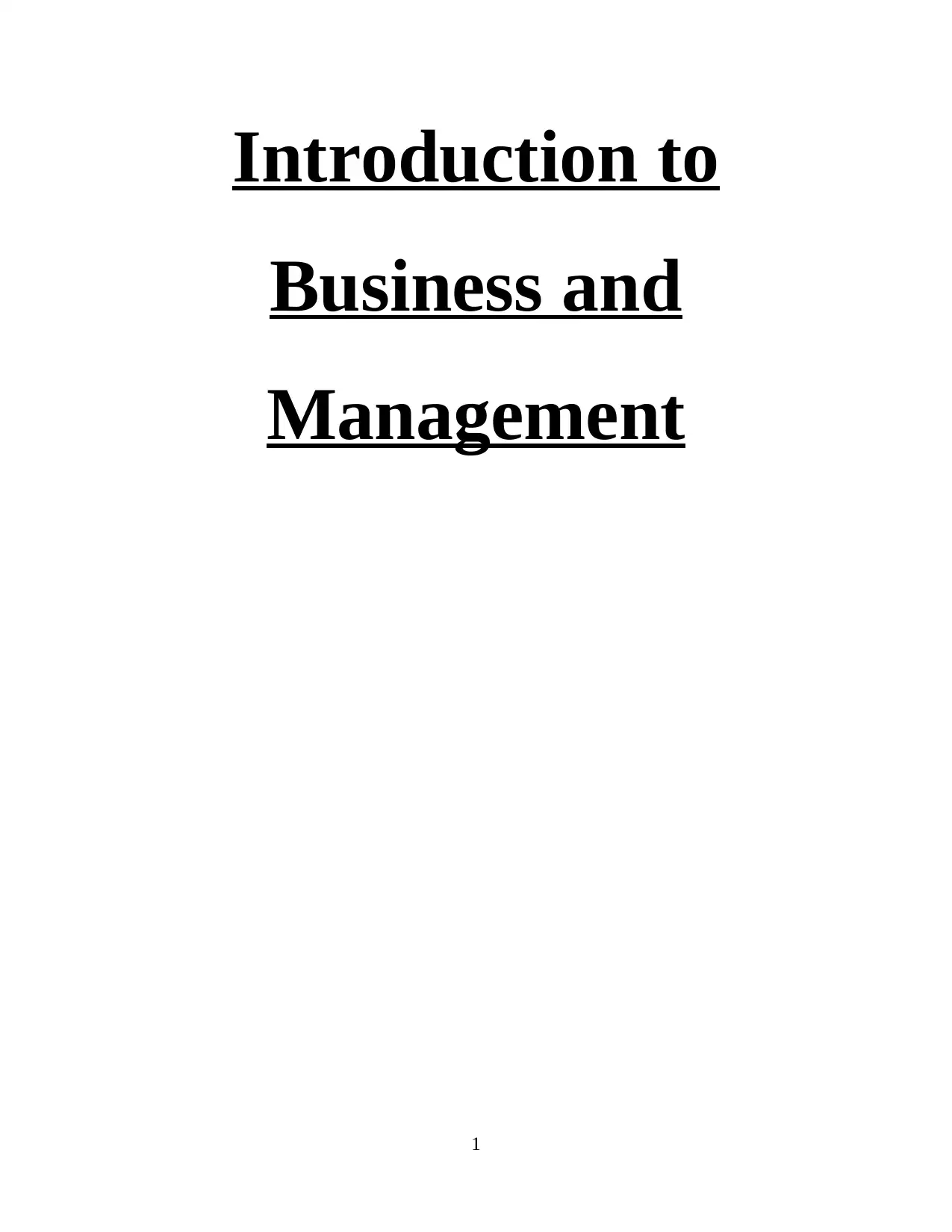
Introduction to
Business and
Management
1
Business and
Management
1
Paraphrase This Document
Need a fresh take? Get an instant paraphrase of this document with our AI Paraphraser
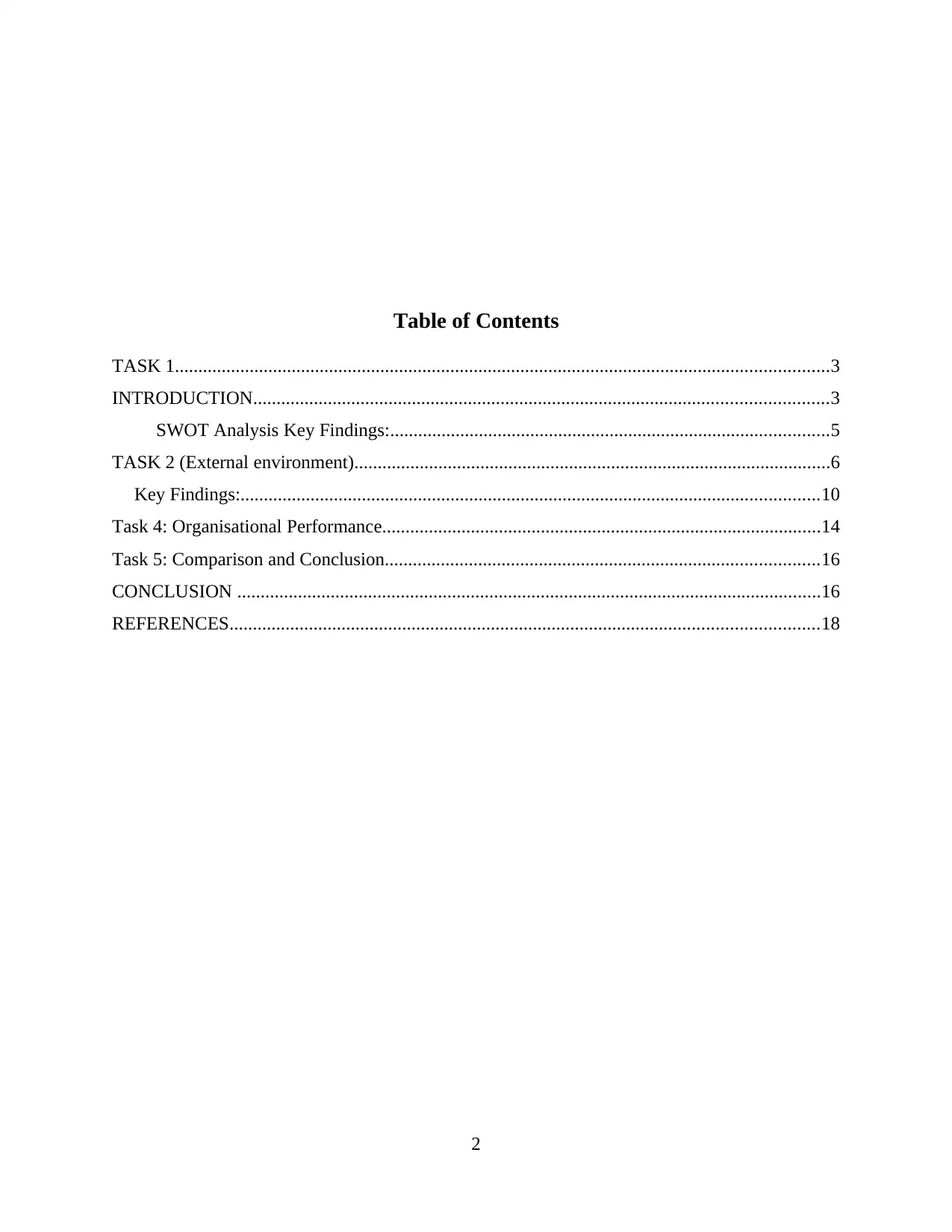
Table of Contents
TASK 1............................................................................................................................................3
INTRODUCTION...........................................................................................................................3
SWOT Analysis Key Findings:..............................................................................................5
TASK 2 (External environment)......................................................................................................6
Key Findings:............................................................................................................................10
Task 4: Organisational Performance..............................................................................................14
Task 5: Comparison and Conclusion.............................................................................................16
CONCLUSION .............................................................................................................................16
REFERENCES..............................................................................................................................18
2
TASK 1............................................................................................................................................3
INTRODUCTION...........................................................................................................................3
SWOT Analysis Key Findings:..............................................................................................5
TASK 2 (External environment)......................................................................................................6
Key Findings:............................................................................................................................10
Task 4: Organisational Performance..............................................................................................14
Task 5: Comparison and Conclusion.............................................................................................16
CONCLUSION .............................................................................................................................16
REFERENCES..............................................................................................................................18
2
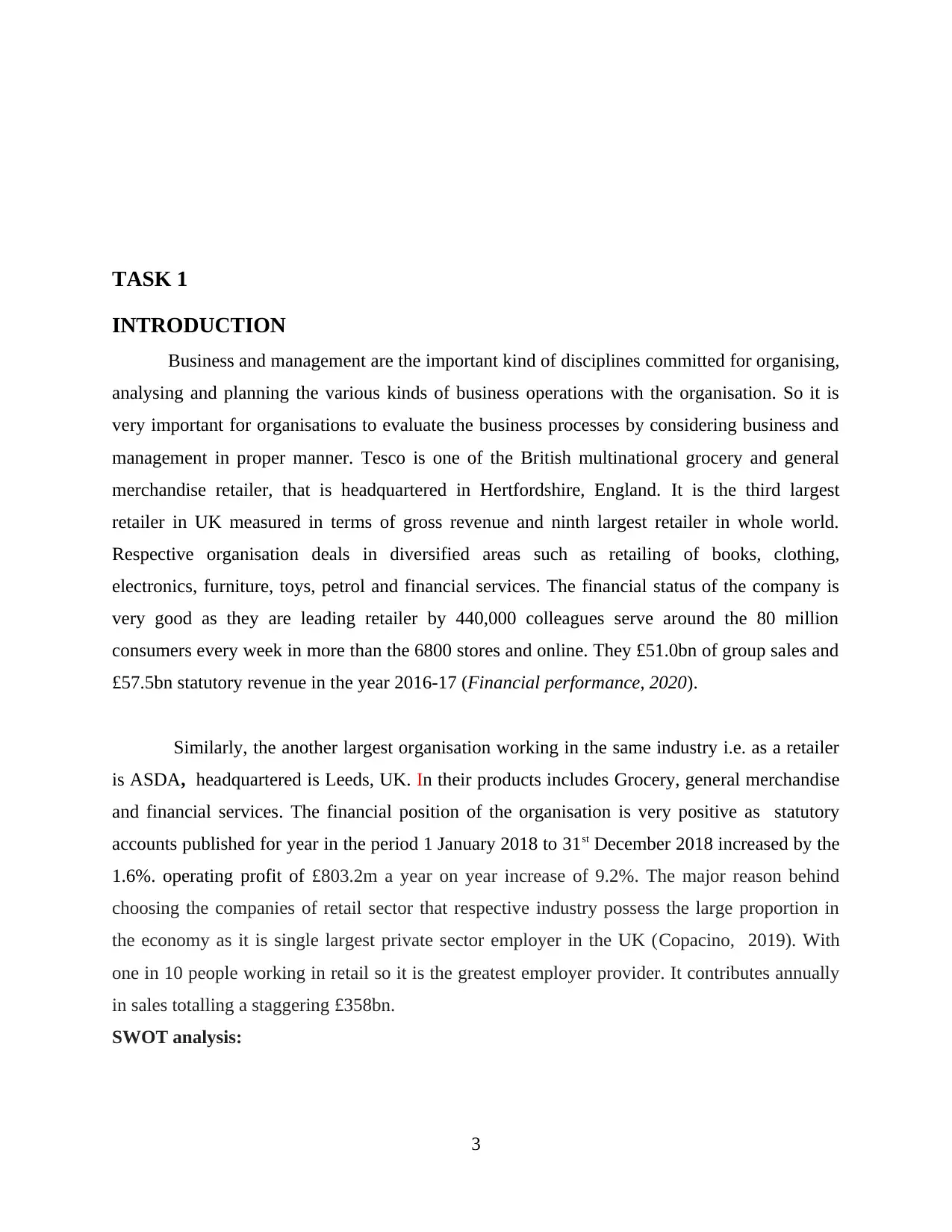
TASK 1
INTRODUCTION
Business and management are the important kind of disciplines committed for organising,
analysing and planning the various kinds of business operations with the organisation. So it is
very important for organisations to evaluate the business processes by considering business and
management in proper manner. Tesco is one of the British multinational grocery and general
merchandise retailer, that is headquartered in Hertfordshire, England. It is the third largest
retailer in UK measured in terms of gross revenue and ninth largest retailer in whole world.
Respective organisation deals in diversified areas such as retailing of books, clothing,
electronics, furniture, toys, petrol and financial services. The financial status of the company is
very good as they are leading retailer by 440,000 colleagues serve around the 80 million
consumers every week in more than the 6800 stores and online. They £51.0bn of group sales and
£57.5bn statutory revenue in the year 2016-17 (Financial performance, 2020).
Similarly, the another largest organisation working in the same industry i.e. as a retailer
is ASDA, headquartered is Leeds, UK. In their products includes Grocery, general merchandise
and financial services. The financial position of the organisation is very positive as statutory
accounts published for year in the period 1 January 2018 to 31st December 2018 increased by the
1.6%. operating profit of £803.2m a year on year increase of 9.2%. The major reason behind
choosing the companies of retail sector that respective industry possess the large proportion in
the economy as it is single largest private sector employer in the UK (Copacino, 2019). With
one in 10 people working in retail so it is the greatest employer provider. It contributes annually
in sales totalling a staggering £358bn.
SWOT analysis:
3
INTRODUCTION
Business and management are the important kind of disciplines committed for organising,
analysing and planning the various kinds of business operations with the organisation. So it is
very important for organisations to evaluate the business processes by considering business and
management in proper manner. Tesco is one of the British multinational grocery and general
merchandise retailer, that is headquartered in Hertfordshire, England. It is the third largest
retailer in UK measured in terms of gross revenue and ninth largest retailer in whole world.
Respective organisation deals in diversified areas such as retailing of books, clothing,
electronics, furniture, toys, petrol and financial services. The financial status of the company is
very good as they are leading retailer by 440,000 colleagues serve around the 80 million
consumers every week in more than the 6800 stores and online. They £51.0bn of group sales and
£57.5bn statutory revenue in the year 2016-17 (Financial performance, 2020).
Similarly, the another largest organisation working in the same industry i.e. as a retailer
is ASDA, headquartered is Leeds, UK. In their products includes Grocery, general merchandise
and financial services. The financial position of the organisation is very positive as statutory
accounts published for year in the period 1 January 2018 to 31st December 2018 increased by the
1.6%. operating profit of £803.2m a year on year increase of 9.2%. The major reason behind
choosing the companies of retail sector that respective industry possess the large proportion in
the economy as it is single largest private sector employer in the UK (Copacino, 2019). With
one in 10 people working in retail so it is the greatest employer provider. It contributes annually
in sales totalling a staggering £358bn.
SWOT analysis:
3
⊘ This is a preview!⊘
Do you want full access?
Subscribe today to unlock all pages.

Trusted by 1+ million students worldwide
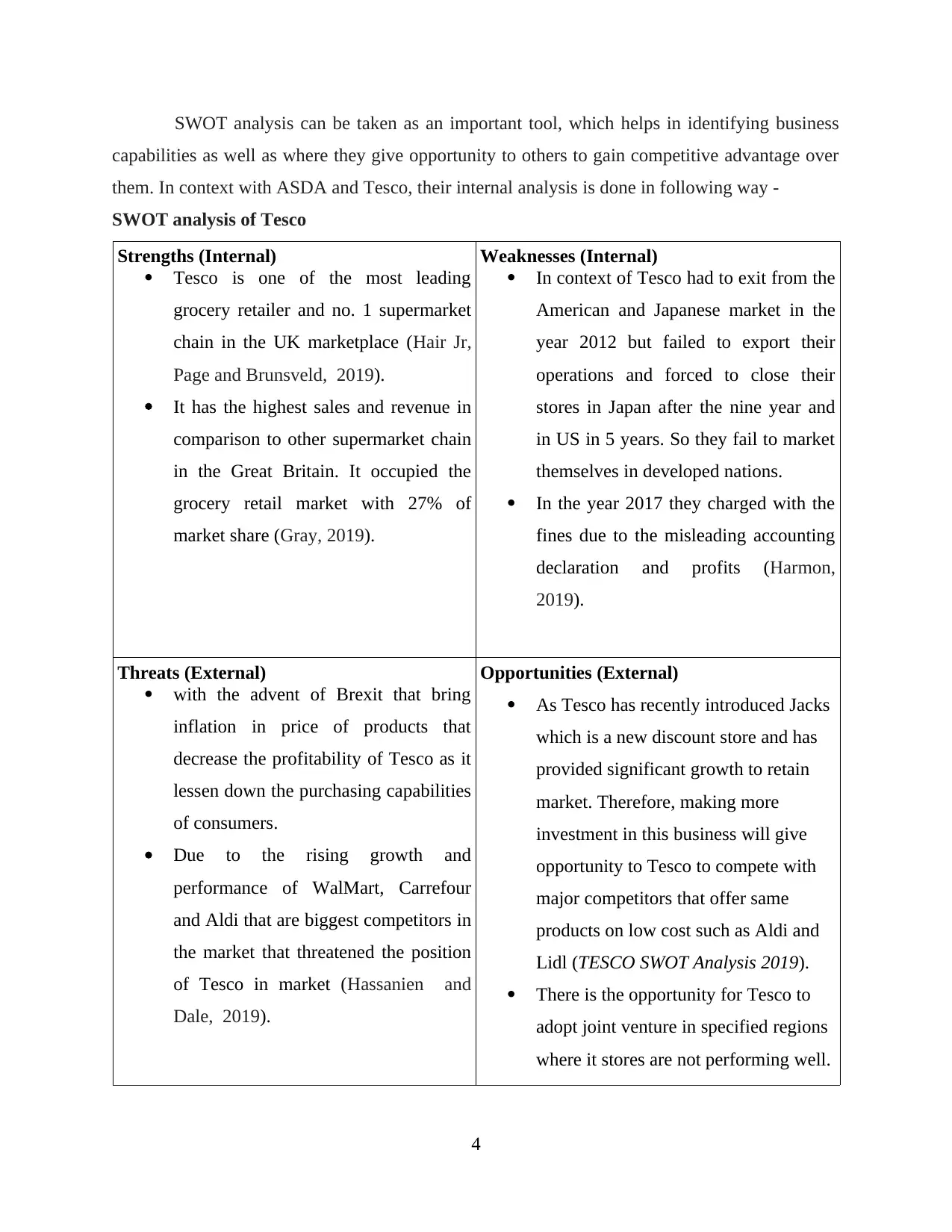
SWOT analysis can be taken as an important tool, which helps in identifying business
capabilities as well as where they give opportunity to others to gain competitive advantage over
them. In context with ASDA and Tesco, their internal analysis is done in following way -
SWOT analysis of Tesco
Strengths (Internal)
Tesco is one of the most leading
grocery retailer and no. 1 supermarket
chain in the UK marketplace (Hair Jr,
Page and Brunsveld, 2019).
It has the highest sales and revenue in
comparison to other supermarket chain
in the Great Britain. It occupied the
grocery retail market with 27% of
market share (Gray, 2019).
Weaknesses (Internal)
In context of Tesco had to exit from the
American and Japanese market in the
year 2012 but failed to export their
operations and forced to close their
stores in Japan after the nine year and
in US in 5 years. So they fail to market
themselves in developed nations.
In the year 2017 they charged with the
fines due to the misleading accounting
declaration and profits (Harmon,
2019).
Threats (External)
with the advent of Brexit that bring
inflation in price of products that
decrease the profitability of Tesco as it
lessen down the purchasing capabilities
of consumers.
Due to the rising growth and
performance of WalMart, Carrefour
and Aldi that are biggest competitors in
the market that threatened the position
of Tesco in market (Hassanien and
Dale, 2019).
Opportunities (External)
As Tesco has recently introduced Jacks
which is a new discount store and has
provided significant growth to retain
market. Therefore, making more
investment in this business will give
opportunity to Tesco to compete with
major competitors that offer same
products on low cost such as Aldi and
Lidl (TESCO SWOT Analysis 2019).
There is the opportunity for Tesco to
adopt joint venture in specified regions
where it stores are not performing well.
4
capabilities as well as where they give opportunity to others to gain competitive advantage over
them. In context with ASDA and Tesco, their internal analysis is done in following way -
SWOT analysis of Tesco
Strengths (Internal)
Tesco is one of the most leading
grocery retailer and no. 1 supermarket
chain in the UK marketplace (Hair Jr,
Page and Brunsveld, 2019).
It has the highest sales and revenue in
comparison to other supermarket chain
in the Great Britain. It occupied the
grocery retail market with 27% of
market share (Gray, 2019).
Weaknesses (Internal)
In context of Tesco had to exit from the
American and Japanese market in the
year 2012 but failed to export their
operations and forced to close their
stores in Japan after the nine year and
in US in 5 years. So they fail to market
themselves in developed nations.
In the year 2017 they charged with the
fines due to the misleading accounting
declaration and profits (Harmon,
2019).
Threats (External)
with the advent of Brexit that bring
inflation in price of products that
decrease the profitability of Tesco as it
lessen down the purchasing capabilities
of consumers.
Due to the rising growth and
performance of WalMart, Carrefour
and Aldi that are biggest competitors in
the market that threatened the position
of Tesco in market (Hassanien and
Dale, 2019).
Opportunities (External)
As Tesco has recently introduced Jacks
which is a new discount store and has
provided significant growth to retain
market. Therefore, making more
investment in this business will give
opportunity to Tesco to compete with
major competitors that offer same
products on low cost such as Aldi and
Lidl (TESCO SWOT Analysis 2019).
There is the opportunity for Tesco to
adopt joint venture in specified regions
where it stores are not performing well.
4
Paraphrase This Document
Need a fresh take? Get an instant paraphrase of this document with our AI Paraphraser
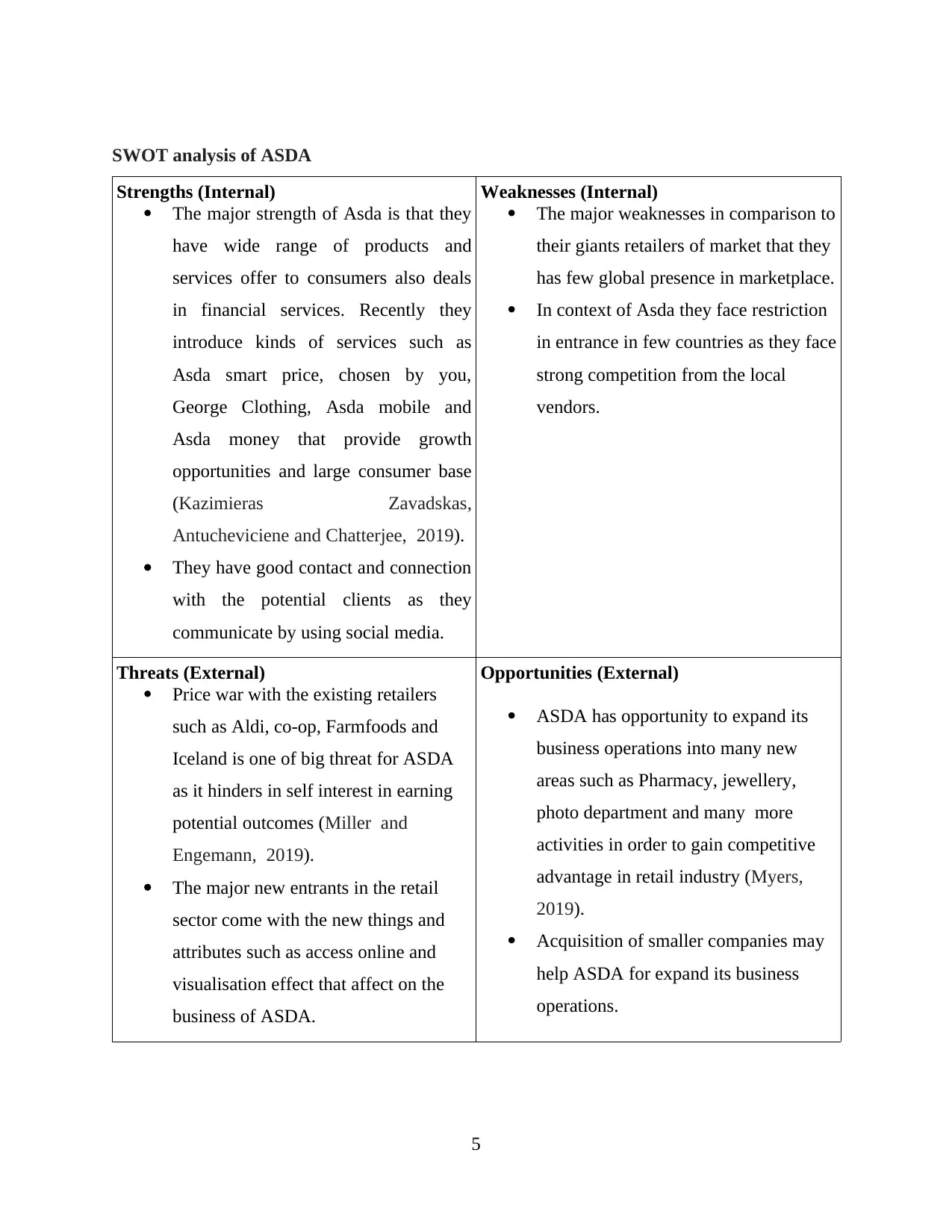
SWOT analysis of ASDA
Strengths (Internal)
The major strength of Asda is that they
have wide range of products and
services offer to consumers also deals
in financial services. Recently they
introduce kinds of services such as
Asda smart price, chosen by you,
George Clothing, Asda mobile and
Asda money that provide growth
opportunities and large consumer base
(Kazimieras Zavadskas,
Antucheviciene and Chatterjee, 2019).
They have good contact and connection
with the potential clients as they
communicate by using social media.
Weaknesses (Internal)
The major weaknesses in comparison to
their giants retailers of market that they
has few global presence in marketplace.
In context of Asda they face restriction
in entrance in few countries as they face
strong competition from the local
vendors.
Threats (External)
Price war with the existing retailers
such as Aldi, co-op, Farmfoods and
Iceland is one of big threat for ASDA
as it hinders in self interest in earning
potential outcomes (Miller and
Engemann, 2019).
The major new entrants in the retail
sector come with the new things and
attributes such as access online and
visualisation effect that affect on the
business of ASDA.
Opportunities (External)
ASDA has opportunity to expand its
business operations into many new
areas such as Pharmacy, jewellery,
photo department and many more
activities in order to gain competitive
advantage in retail industry (Myers,
2019).
Acquisition of smaller companies may
help ASDA for expand its business
operations.
5
Strengths (Internal)
The major strength of Asda is that they
have wide range of products and
services offer to consumers also deals
in financial services. Recently they
introduce kinds of services such as
Asda smart price, chosen by you,
George Clothing, Asda mobile and
Asda money that provide growth
opportunities and large consumer base
(Kazimieras Zavadskas,
Antucheviciene and Chatterjee, 2019).
They have good contact and connection
with the potential clients as they
communicate by using social media.
Weaknesses (Internal)
The major weaknesses in comparison to
their giants retailers of market that they
has few global presence in marketplace.
In context of Asda they face restriction
in entrance in few countries as they face
strong competition from the local
vendors.
Threats (External)
Price war with the existing retailers
such as Aldi, co-op, Farmfoods and
Iceland is one of big threat for ASDA
as it hinders in self interest in earning
potential outcomes (Miller and
Engemann, 2019).
The major new entrants in the retail
sector come with the new things and
attributes such as access online and
visualisation effect that affect on the
business of ASDA.
Opportunities (External)
ASDA has opportunity to expand its
business operations into many new
areas such as Pharmacy, jewellery,
photo department and many more
activities in order to gain competitive
advantage in retail industry (Myers,
2019).
Acquisition of smaller companies may
help ASDA for expand its business
operations.
5
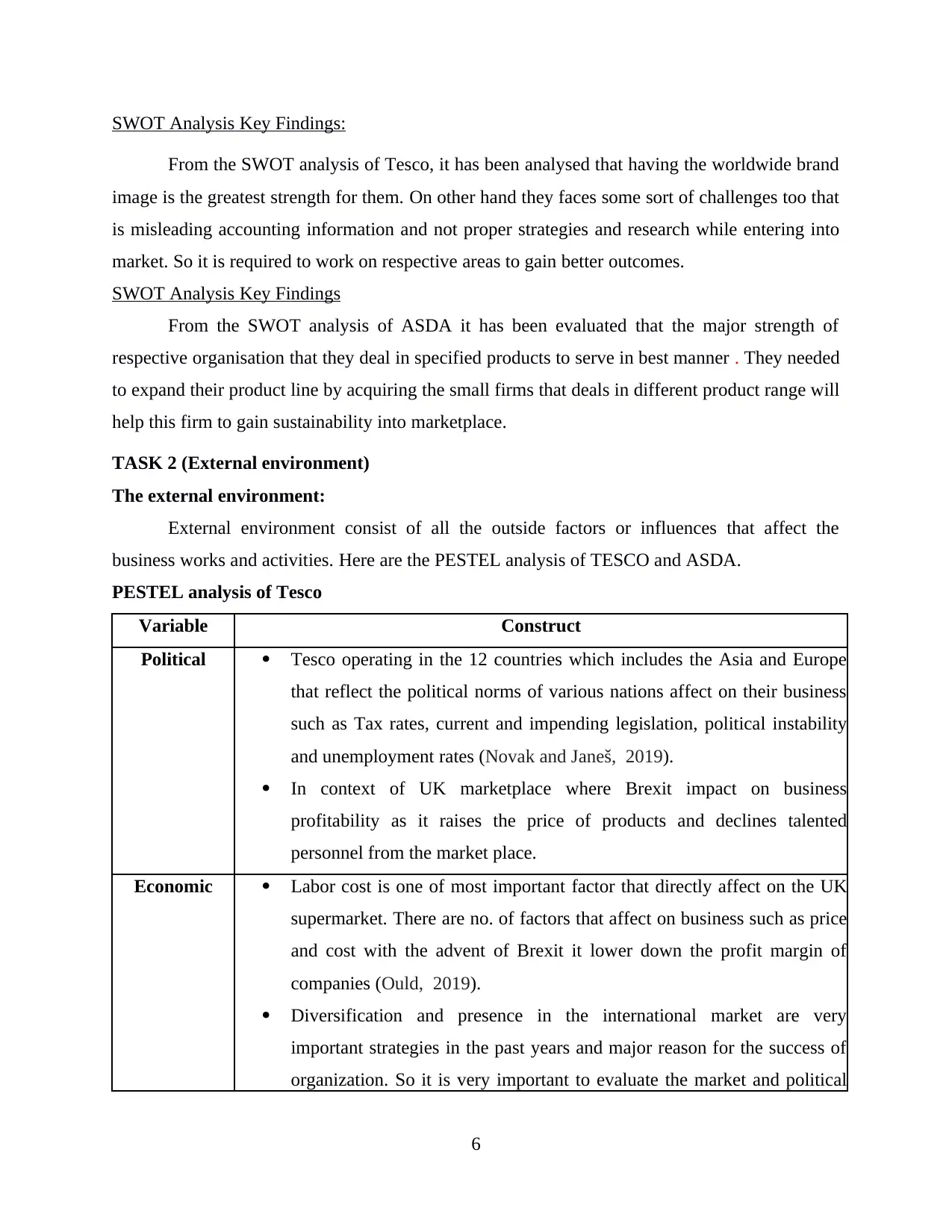
SWOT Analysis Key Findings:
From the SWOT analysis of Tesco, it has been analysed that having the worldwide brand
image is the greatest strength for them. On other hand they faces some sort of challenges too that
is misleading accounting information and not proper strategies and research while entering into
market. So it is required to work on respective areas to gain better outcomes.
SWOT Analysis Key Findings
From the SWOT analysis of ASDA it has been evaluated that the major strength of
respective organisation that they deal in specified products to serve in best manner . They needed
to expand their product line by acquiring the small firms that deals in different product range will
help this firm to gain sustainability into marketplace.
TASK 2 (External environment)
The external environment:
External environment consist of all the outside factors or influences that affect the
business works and activities. Here are the PESTEL analysis of TESCO and ASDA.
PESTEL analysis of Tesco
Variable Construct
Political Tesco operating in the 12 countries which includes the Asia and Europe
that reflect the political norms of various nations affect on their business
such as Tax rates, current and impending legislation, political instability
and unemployment rates (Novak and Janeš, 2019).
In context of UK marketplace where Brexit impact on business
profitability as it raises the price of products and declines talented
personnel from the market place.
Economic Labor cost is one of most important factor that directly affect on the UK
supermarket. There are no. of factors that affect on business such as price
and cost with the advent of Brexit it lower down the profit margin of
companies (Ould, 2019).
Diversification and presence in the international market are very
important strategies in the past years and major reason for the success of
organization. So it is very important to evaluate the market and political
6
From the SWOT analysis of Tesco, it has been analysed that having the worldwide brand
image is the greatest strength for them. On other hand they faces some sort of challenges too that
is misleading accounting information and not proper strategies and research while entering into
market. So it is required to work on respective areas to gain better outcomes.
SWOT Analysis Key Findings
From the SWOT analysis of ASDA it has been evaluated that the major strength of
respective organisation that they deal in specified products to serve in best manner . They needed
to expand their product line by acquiring the small firms that deals in different product range will
help this firm to gain sustainability into marketplace.
TASK 2 (External environment)
The external environment:
External environment consist of all the outside factors or influences that affect the
business works and activities. Here are the PESTEL analysis of TESCO and ASDA.
PESTEL analysis of Tesco
Variable Construct
Political Tesco operating in the 12 countries which includes the Asia and Europe
that reflect the political norms of various nations affect on their business
such as Tax rates, current and impending legislation, political instability
and unemployment rates (Novak and Janeš, 2019).
In context of UK marketplace where Brexit impact on business
profitability as it raises the price of products and declines talented
personnel from the market place.
Economic Labor cost is one of most important factor that directly affect on the UK
supermarket. There are no. of factors that affect on business such as price
and cost with the advent of Brexit it lower down the profit margin of
companies (Ould, 2019).
Diversification and presence in the international market are very
important strategies in the past years and major reason for the success of
organization. So it is very important to evaluate the market and political
6
⊘ This is a preview!⊘
Do you want full access?
Subscribe today to unlock all pages.

Trusted by 1+ million students worldwide
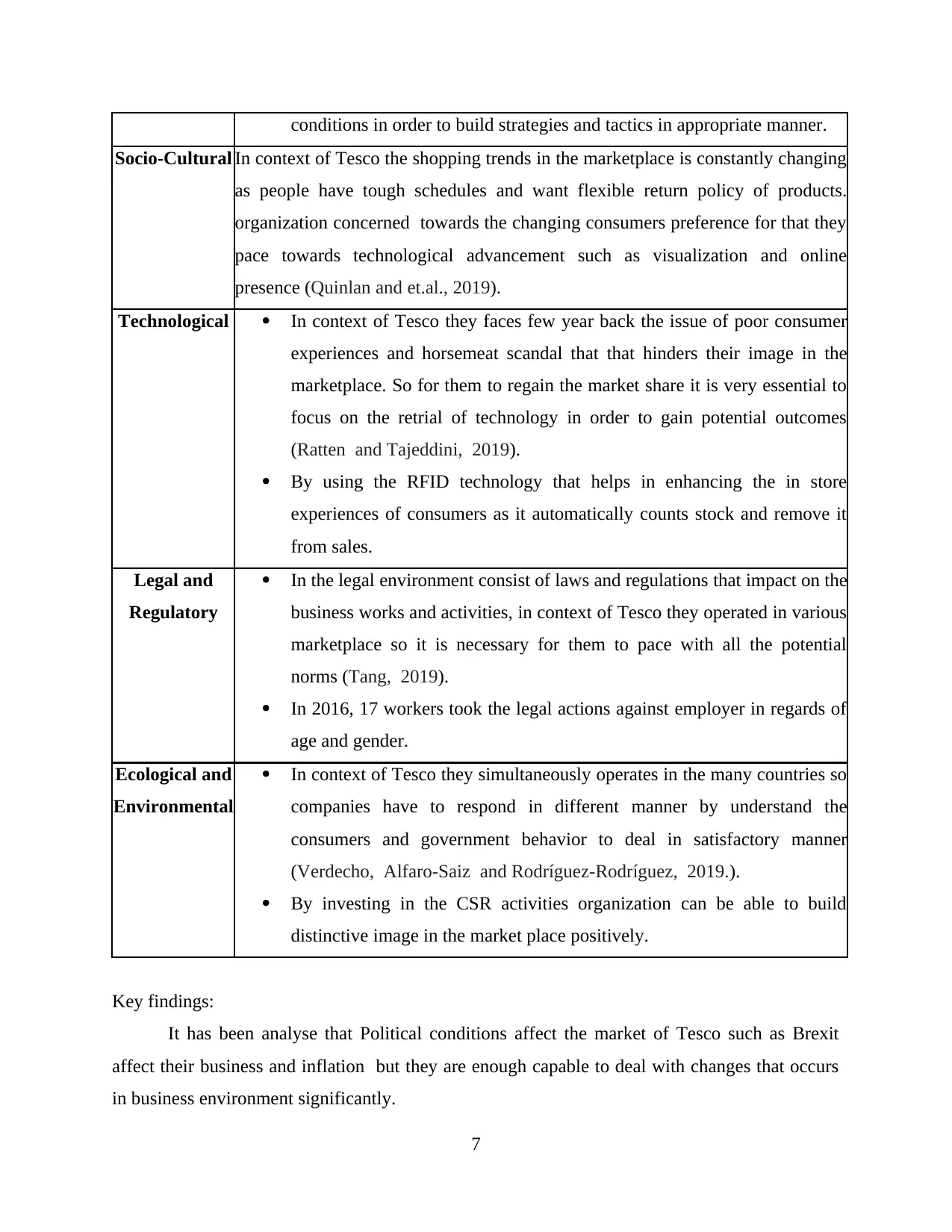
conditions in order to build strategies and tactics in appropriate manner.
Socio-Cultural In context of Tesco the shopping trends in the marketplace is constantly changing
as people have tough schedules and want flexible return policy of products.
organization concerned towards the changing consumers preference for that they
pace towards technological advancement such as visualization and online
presence (Quinlan and et.al., 2019).
Technological In context of Tesco they faces few year back the issue of poor consumer
experiences and horsemeat scandal that that hinders their image in the
marketplace. So for them to regain the market share it is very essential to
focus on the retrial of technology in order to gain potential outcomes
(Ratten and Tajeddini, 2019).
By using the RFID technology that helps in enhancing the in store
experiences of consumers as it automatically counts stock and remove it
from sales.
Legal and
Regulatory
In the legal environment consist of laws and regulations that impact on the
business works and activities, in context of Tesco they operated in various
marketplace so it is necessary for them to pace with all the potential
norms (Tang, 2019).
In 2016, 17 workers took the legal actions against employer in regards of
age and gender.
Ecological and
Environmental
In context of Tesco they simultaneously operates in the many countries so
companies have to respond in different manner by understand the
consumers and government behavior to deal in satisfactory manner
(Verdecho, Alfaro-Saiz and Rodríguez-Rodríguez, 2019.).
By investing in the CSR activities organization can be able to build
distinctive image in the market place positively.
Key findings:
It has been analyse that Political conditions affect the market of Tesco such as Brexit
affect their business and inflation but they are enough capable to deal with changes that occurs
in business environment significantly.
7
Socio-Cultural In context of Tesco the shopping trends in the marketplace is constantly changing
as people have tough schedules and want flexible return policy of products.
organization concerned towards the changing consumers preference for that they
pace towards technological advancement such as visualization and online
presence (Quinlan and et.al., 2019).
Technological In context of Tesco they faces few year back the issue of poor consumer
experiences and horsemeat scandal that that hinders their image in the
marketplace. So for them to regain the market share it is very essential to
focus on the retrial of technology in order to gain potential outcomes
(Ratten and Tajeddini, 2019).
By using the RFID technology that helps in enhancing the in store
experiences of consumers as it automatically counts stock and remove it
from sales.
Legal and
Regulatory
In the legal environment consist of laws and regulations that impact on the
business works and activities, in context of Tesco they operated in various
marketplace so it is necessary for them to pace with all the potential
norms (Tang, 2019).
In 2016, 17 workers took the legal actions against employer in regards of
age and gender.
Ecological and
Environmental
In context of Tesco they simultaneously operates in the many countries so
companies have to respond in different manner by understand the
consumers and government behavior to deal in satisfactory manner
(Verdecho, Alfaro-Saiz and Rodríguez-Rodríguez, 2019.).
By investing in the CSR activities organization can be able to build
distinctive image in the market place positively.
Key findings:
It has been analyse that Political conditions affect the market of Tesco such as Brexit
affect their business and inflation but they are enough capable to deal with changes that occurs
in business environment significantly.
7
Paraphrase This Document
Need a fresh take? Get an instant paraphrase of this document with our AI Paraphraser

PESTEL analysis of ASDA:
Variable Construct
Political In context of ASDA they deals in the various products range, recently
increasing taxes has been announced from the side of conservative alcohol
policy so they affected from the tax regimes in UK while dealing in the
various nations. So it is very essential for them to evaluate the market
keenly to build strategies and tactics (von Rosing and Laurier, 2020).
National and international with EU regulations directly affect the
employment, legislation and consumer rights that impact on the
organizational activities.
Economic With the budget looming and coalition economic policy that required to
pay attention. They deals in the range of products so it is very essential for
them to assign the budget on each of the product category.
The Brexit affect on their profitability as it reduces the purchasing
capabilities. So it is very essential for them to evaluate the market to build
proper strategies and tactics (Aaboen and et. al., 2017).
Socio-Cultural In context of ASDA they deals in the various nations and in differ range
of products to deal with them in positive manner required the changes. As
people become more health conscious and their lifestyle also fast pacing
in that series required to pay attention on respective aspects (Aral,
Dellarocas and Godes, 2013).
Technological To deal in various nations and for gaining sustainability it is required to
adopt technological advancement. In recent world consumers adopt to
new way of shopping such as online and visualization so it is potential for
them to enter into the new product type to beat their fierce competitors
(Barile and et. al., 2012).
Legal and
Regulatory
ASDA abide with kinds of rules and regulations of various nations in
which they operates as breach of law resulting punitive actions by active
authorities. In that series they have to opt the legislation regarding to
provide equal pay for equal wages and not dismiss an employee unfairly
8
Variable Construct
Political In context of ASDA they deals in the various products range, recently
increasing taxes has been announced from the side of conservative alcohol
policy so they affected from the tax regimes in UK while dealing in the
various nations. So it is very essential for them to evaluate the market
keenly to build strategies and tactics (von Rosing and Laurier, 2020).
National and international with EU regulations directly affect the
employment, legislation and consumer rights that impact on the
organizational activities.
Economic With the budget looming and coalition economic policy that required to
pay attention. They deals in the range of products so it is very essential for
them to assign the budget on each of the product category.
The Brexit affect on their profitability as it reduces the purchasing
capabilities. So it is very essential for them to evaluate the market to build
proper strategies and tactics (Aaboen and et. al., 2017).
Socio-Cultural In context of ASDA they deals in the various nations and in differ range
of products to deal with them in positive manner required the changes. As
people become more health conscious and their lifestyle also fast pacing
in that series required to pay attention on respective aspects (Aral,
Dellarocas and Godes, 2013).
Technological To deal in various nations and for gaining sustainability it is required to
adopt technological advancement. In recent world consumers adopt to
new way of shopping such as online and visualization so it is potential for
them to enter into the new product type to beat their fierce competitors
(Barile and et. al., 2012).
Legal and
Regulatory
ASDA abide with kinds of rules and regulations of various nations in
which they operates as breach of law resulting punitive actions by active
authorities. In that series they have to opt the legislation regarding to
provide equal pay for equal wages and not dismiss an employee unfairly
8
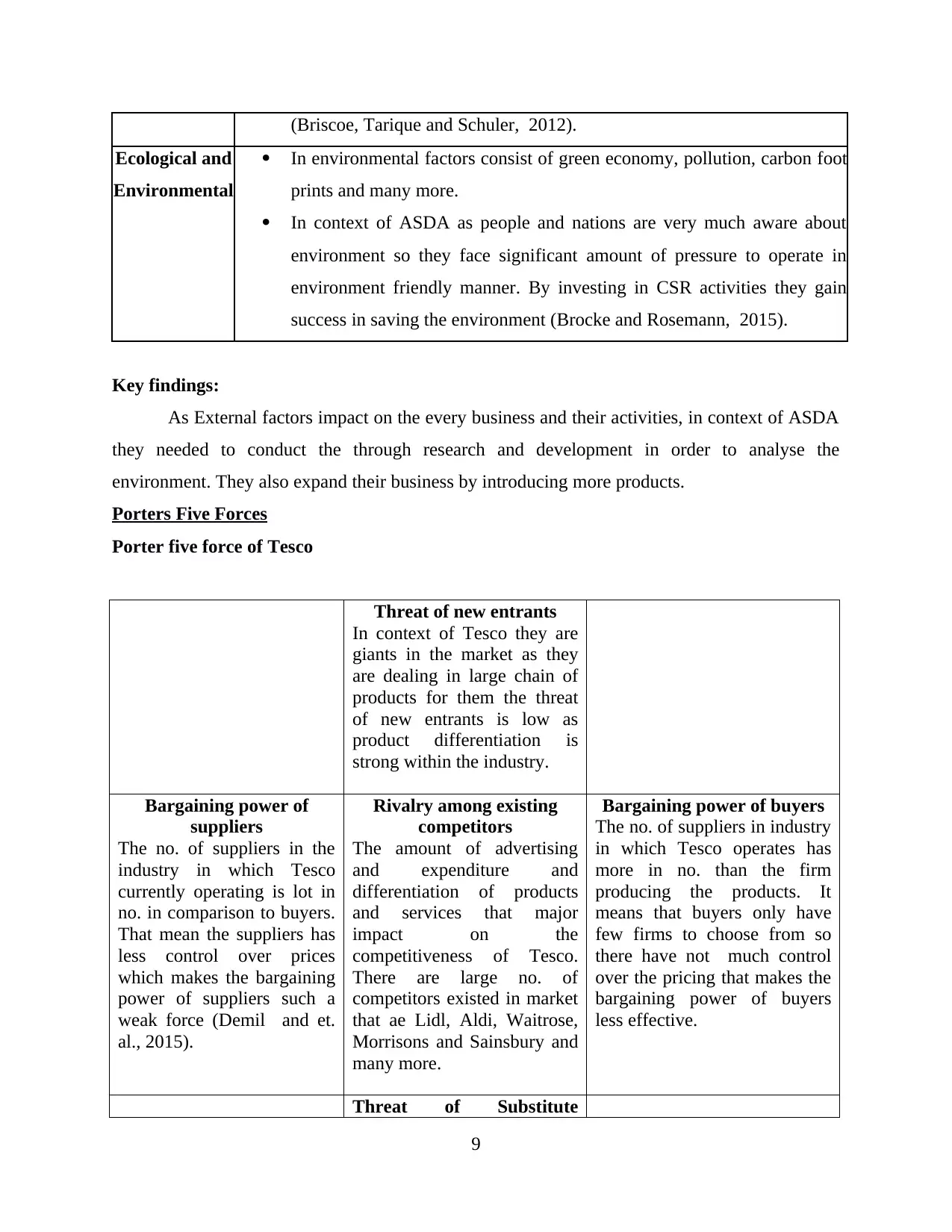
(Briscoe, Tarique and Schuler, 2012).
Ecological and
Environmental
In environmental factors consist of green economy, pollution, carbon foot
prints and many more.
In context of ASDA as people and nations are very much aware about
environment so they face significant amount of pressure to operate in
environment friendly manner. By investing in CSR activities they gain
success in saving the environment (Brocke and Rosemann, 2015).
Key findings:
As External factors impact on the every business and their activities, in context of ASDA
they needed to conduct the through research and development in order to analyse the
environment. They also expand their business by introducing more products.
Porters Five Forces
Porter five force of Tesco
Threat of new entrants
In context of Tesco they are
giants in the market as they
are dealing in large chain of
products for them the threat
of new entrants is low as
product differentiation is
strong within the industry.
Bargaining power of
suppliers
The no. of suppliers in the
industry in which Tesco
currently operating is lot in
no. in comparison to buyers.
That mean the suppliers has
less control over prices
which makes the bargaining
power of suppliers such a
weak force (Demil and et.
al., 2015).
Rivalry among existing
competitors
The amount of advertising
and expenditure and
differentiation of products
and services that major
impact on the
competitiveness of Tesco.
There are large no. of
competitors existed in market
that ae Lidl, Aldi, Waitrose,
Morrisons and Sainsbury and
many more.
Bargaining power of buyers
The no. of suppliers in industry
in which Tesco operates has
more in no. than the firm
producing the products. It
means that buyers only have
few firms to choose from so
there have not much control
over the pricing that makes the
bargaining power of buyers
less effective.
Threat of Substitute
9
Ecological and
Environmental
In environmental factors consist of green economy, pollution, carbon foot
prints and many more.
In context of ASDA as people and nations are very much aware about
environment so they face significant amount of pressure to operate in
environment friendly manner. By investing in CSR activities they gain
success in saving the environment (Brocke and Rosemann, 2015).
Key findings:
As External factors impact on the every business and their activities, in context of ASDA
they needed to conduct the through research and development in order to analyse the
environment. They also expand their business by introducing more products.
Porters Five Forces
Porter five force of Tesco
Threat of new entrants
In context of Tesco they are
giants in the market as they
are dealing in large chain of
products for them the threat
of new entrants is low as
product differentiation is
strong within the industry.
Bargaining power of
suppliers
The no. of suppliers in the
industry in which Tesco
currently operating is lot in
no. in comparison to buyers.
That mean the suppliers has
less control over prices
which makes the bargaining
power of suppliers such a
weak force (Demil and et.
al., 2015).
Rivalry among existing
competitors
The amount of advertising
and expenditure and
differentiation of products
and services that major
impact on the
competitiveness of Tesco.
There are large no. of
competitors existed in market
that ae Lidl, Aldi, Waitrose,
Morrisons and Sainsbury and
many more.
Bargaining power of buyers
The no. of suppliers in industry
in which Tesco operates has
more in no. than the firm
producing the products. It
means that buyers only have
few firms to choose from so
there have not much control
over the pricing that makes the
bargaining power of buyers
less effective.
Threat of Substitute
9
⊘ This is a preview!⊘
Do you want full access?
Subscribe today to unlock all pages.

Trusted by 1+ million students worldwide
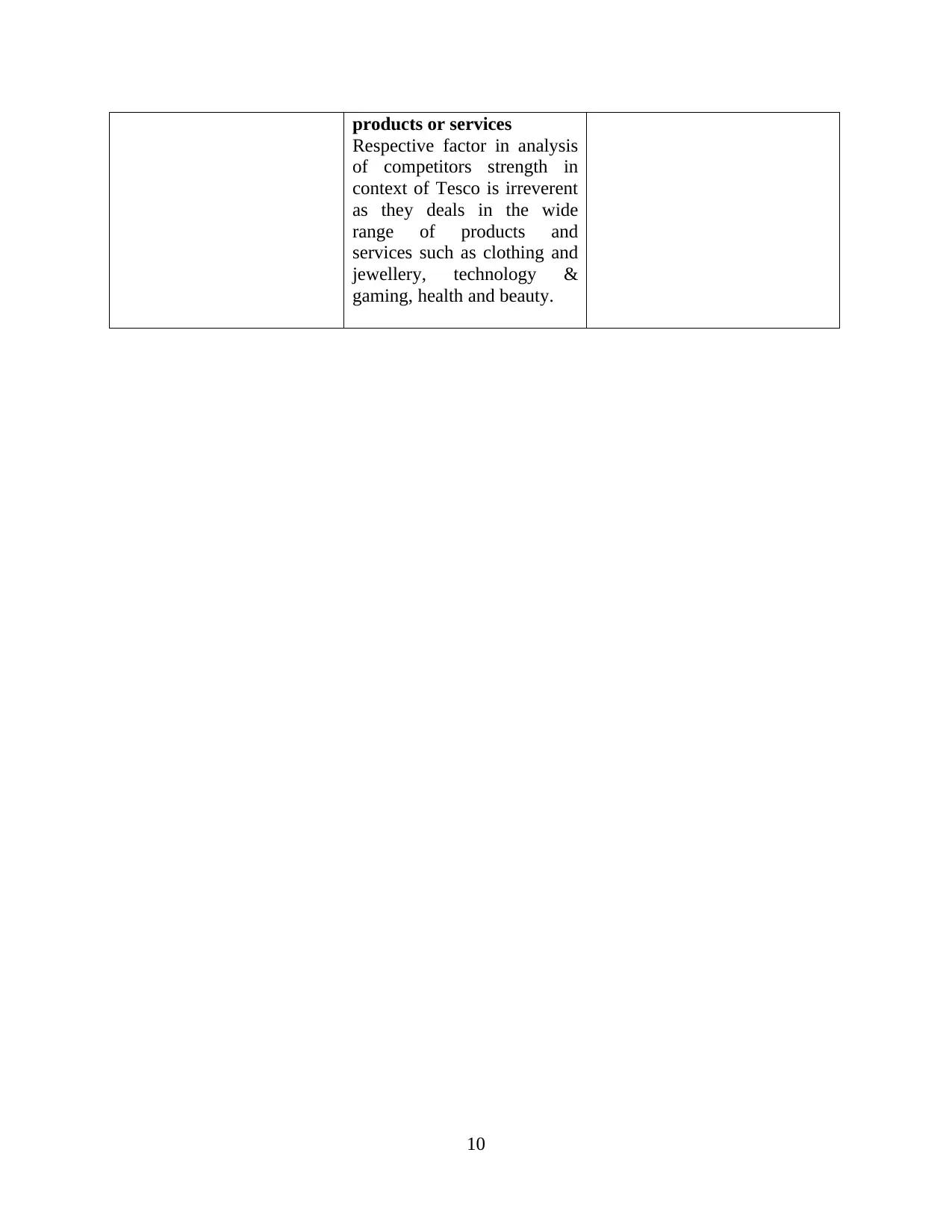
products or services
Respective factor in analysis
of competitors strength in
context of Tesco is irreverent
as they deals in the wide
range of products and
services such as clothing and
jewellery, technology &
gaming, health and beauty.
10
Respective factor in analysis
of competitors strength in
context of Tesco is irreverent
as they deals in the wide
range of products and
services such as clothing and
jewellery, technology &
gaming, health and beauty.
10
Paraphrase This Document
Need a fresh take? Get an instant paraphrase of this document with our AI Paraphraser
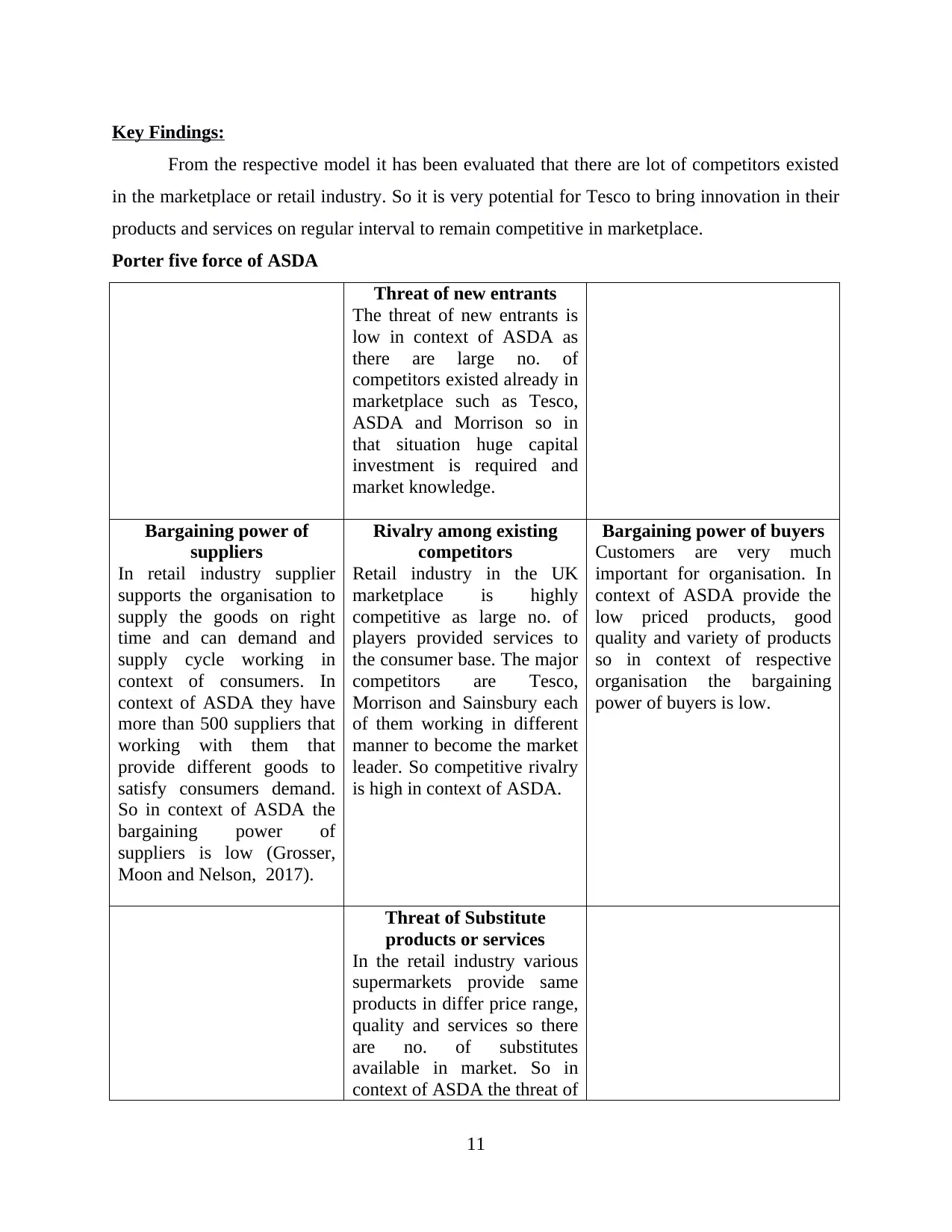
Key Findings:
From the respective model it has been evaluated that there are lot of competitors existed
in the marketplace or retail industry. So it is very potential for Tesco to bring innovation in their
products and services on regular interval to remain competitive in marketplace.
Porter five force of ASDA
Threat of new entrants
The threat of new entrants is
low in context of ASDA as
there are large no. of
competitors existed already in
marketplace such as Tesco,
ASDA and Morrison so in
that situation huge capital
investment is required and
market knowledge.
Bargaining power of
suppliers
In retail industry supplier
supports the organisation to
supply the goods on right
time and can demand and
supply cycle working in
context of consumers. In
context of ASDA they have
more than 500 suppliers that
working with them that
provide different goods to
satisfy consumers demand.
So in context of ASDA the
bargaining power of
suppliers is low (Grosser,
Moon and Nelson, 2017).
Rivalry among existing
competitors
Retail industry in the UK
marketplace is highly
competitive as large no. of
players provided services to
the consumer base. The major
competitors are Tesco,
Morrison and Sainsbury each
of them working in different
manner to become the market
leader. So competitive rivalry
is high in context of ASDA.
Bargaining power of buyers
Customers are very much
important for organisation. In
context of ASDA provide the
low priced products, good
quality and variety of products
so in context of respective
organisation the bargaining
power of buyers is low.
Threat of Substitute
products or services
In the retail industry various
supermarkets provide same
products in differ price range,
quality and services so there
are no. of substitutes
available in market. So in
context of ASDA the threat of
11
From the respective model it has been evaluated that there are lot of competitors existed
in the marketplace or retail industry. So it is very potential for Tesco to bring innovation in their
products and services on regular interval to remain competitive in marketplace.
Porter five force of ASDA
Threat of new entrants
The threat of new entrants is
low in context of ASDA as
there are large no. of
competitors existed already in
marketplace such as Tesco,
ASDA and Morrison so in
that situation huge capital
investment is required and
market knowledge.
Bargaining power of
suppliers
In retail industry supplier
supports the organisation to
supply the goods on right
time and can demand and
supply cycle working in
context of consumers. In
context of ASDA they have
more than 500 suppliers that
working with them that
provide different goods to
satisfy consumers demand.
So in context of ASDA the
bargaining power of
suppliers is low (Grosser,
Moon and Nelson, 2017).
Rivalry among existing
competitors
Retail industry in the UK
marketplace is highly
competitive as large no. of
players provided services to
the consumer base. The major
competitors are Tesco,
Morrison and Sainsbury each
of them working in different
manner to become the market
leader. So competitive rivalry
is high in context of ASDA.
Bargaining power of buyers
Customers are very much
important for organisation. In
context of ASDA provide the
low priced products, good
quality and variety of products
so in context of respective
organisation the bargaining
power of buyers is low.
Threat of Substitute
products or services
In the retail industry various
supermarkets provide same
products in differ price range,
quality and services so there
are no. of substitutes
available in market. So in
context of ASDA the threat of
11
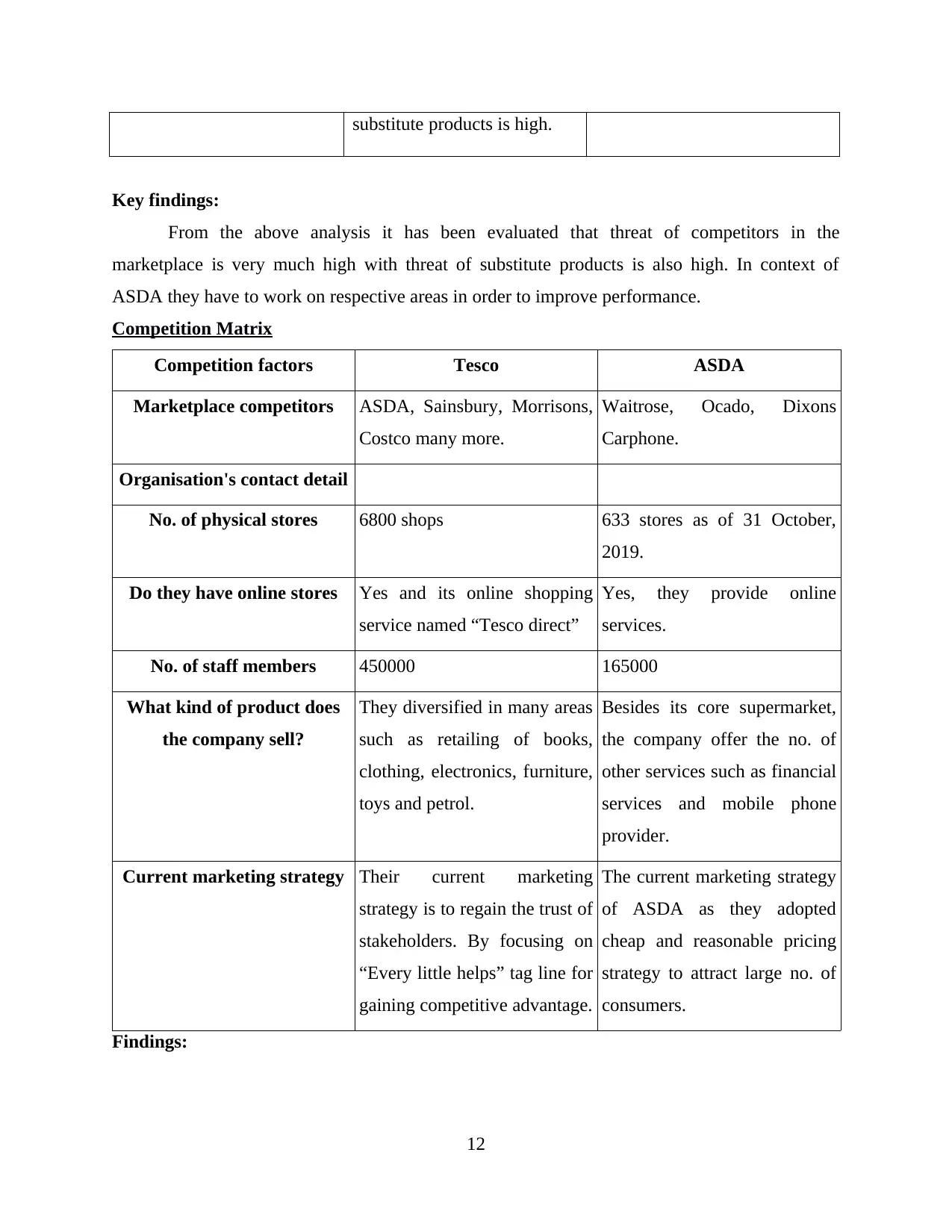
substitute products is high.
Key findings:
From the above analysis it has been evaluated that threat of competitors in the
marketplace is very much high with threat of substitute products is also high. In context of
ASDA they have to work on respective areas in order to improve performance.
Competition Matrix
Competition factors Tesco ASDA
Marketplace competitors ASDA, Sainsbury, Morrisons,
Costco many more.
Waitrose, Ocado, Dixons
Carphone.
Organisation's contact detail
No. of physical stores 6800 shops 633 stores as of 31 October,
2019.
Do they have online stores Yes and its online shopping
service named “Tesco direct”
Yes, they provide online
services.
No. of staff members 450000 165000
What kind of product does
the company sell?
They diversified in many areas
such as retailing of books,
clothing, electronics, furniture,
toys and petrol.
Besides its core supermarket,
the company offer the no. of
other services such as financial
services and mobile phone
provider.
Current marketing strategy Their current marketing
strategy is to regain the trust of
stakeholders. By focusing on
“Every little helps” tag line for
gaining competitive advantage.
The current marketing strategy
of ASDA as they adopted
cheap and reasonable pricing
strategy to attract large no. of
consumers.
Findings:
12
Key findings:
From the above analysis it has been evaluated that threat of competitors in the
marketplace is very much high with threat of substitute products is also high. In context of
ASDA they have to work on respective areas in order to improve performance.
Competition Matrix
Competition factors Tesco ASDA
Marketplace competitors ASDA, Sainsbury, Morrisons,
Costco many more.
Waitrose, Ocado, Dixons
Carphone.
Organisation's contact detail
No. of physical stores 6800 shops 633 stores as of 31 October,
2019.
Do they have online stores Yes and its online shopping
service named “Tesco direct”
Yes, they provide online
services.
No. of staff members 450000 165000
What kind of product does
the company sell?
They diversified in many areas
such as retailing of books,
clothing, electronics, furniture,
toys and petrol.
Besides its core supermarket,
the company offer the no. of
other services such as financial
services and mobile phone
provider.
Current marketing strategy Their current marketing
strategy is to regain the trust of
stakeholders. By focusing on
“Every little helps” tag line for
gaining competitive advantage.
The current marketing strategy
of ASDA as they adopted
cheap and reasonable pricing
strategy to attract large no. of
consumers.
Findings:
12
⊘ This is a preview!⊘
Do you want full access?
Subscribe today to unlock all pages.

Trusted by 1+ million students worldwide
1 out of 22
Related Documents
Your All-in-One AI-Powered Toolkit for Academic Success.
+13062052269
info@desklib.com
Available 24*7 on WhatsApp / Email
![[object Object]](/_next/static/media/star-bottom.7253800d.svg)
Unlock your academic potential
Copyright © 2020–2025 A2Z Services. All Rights Reserved. Developed and managed by ZUCOL.





